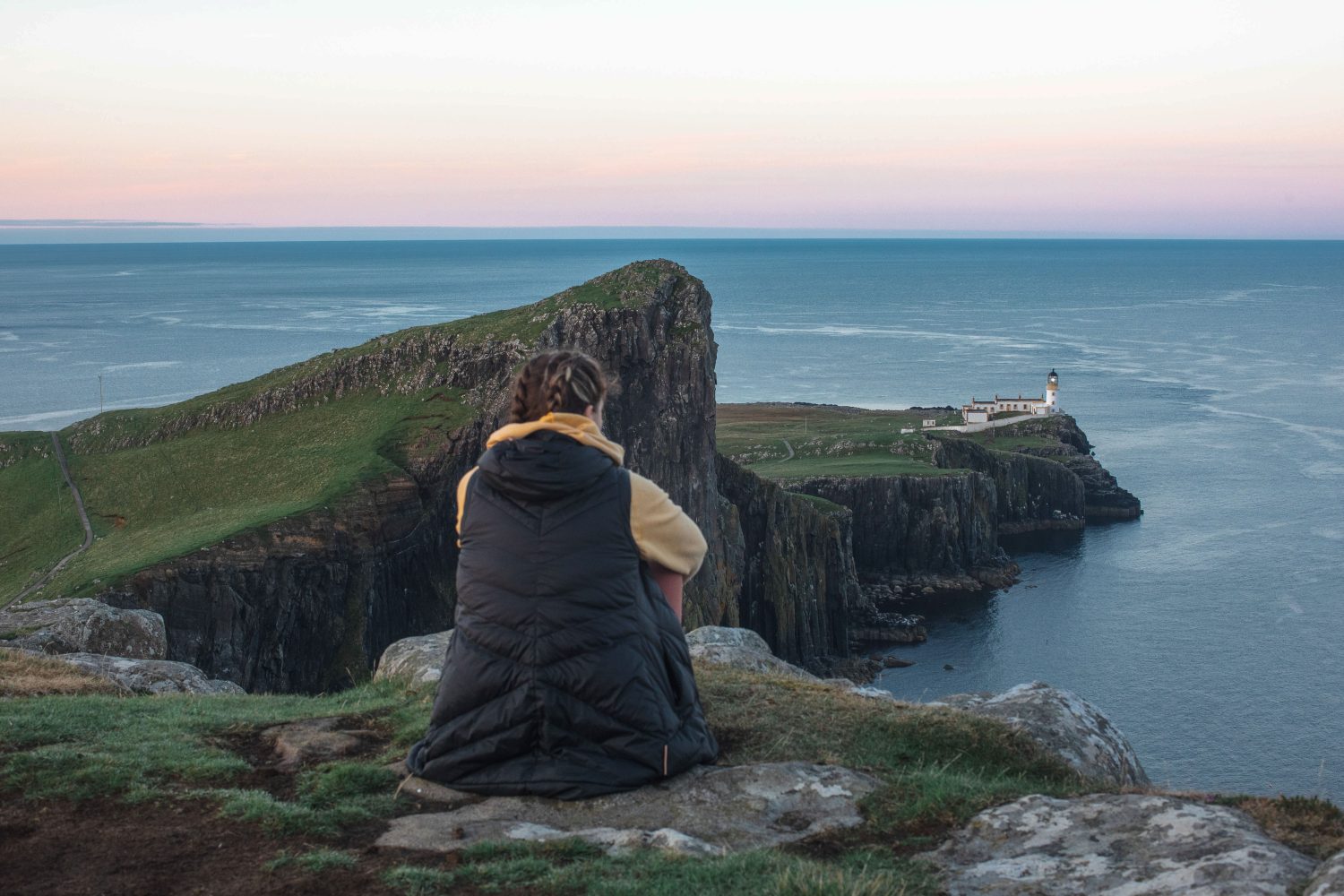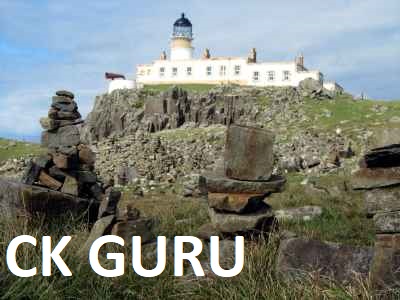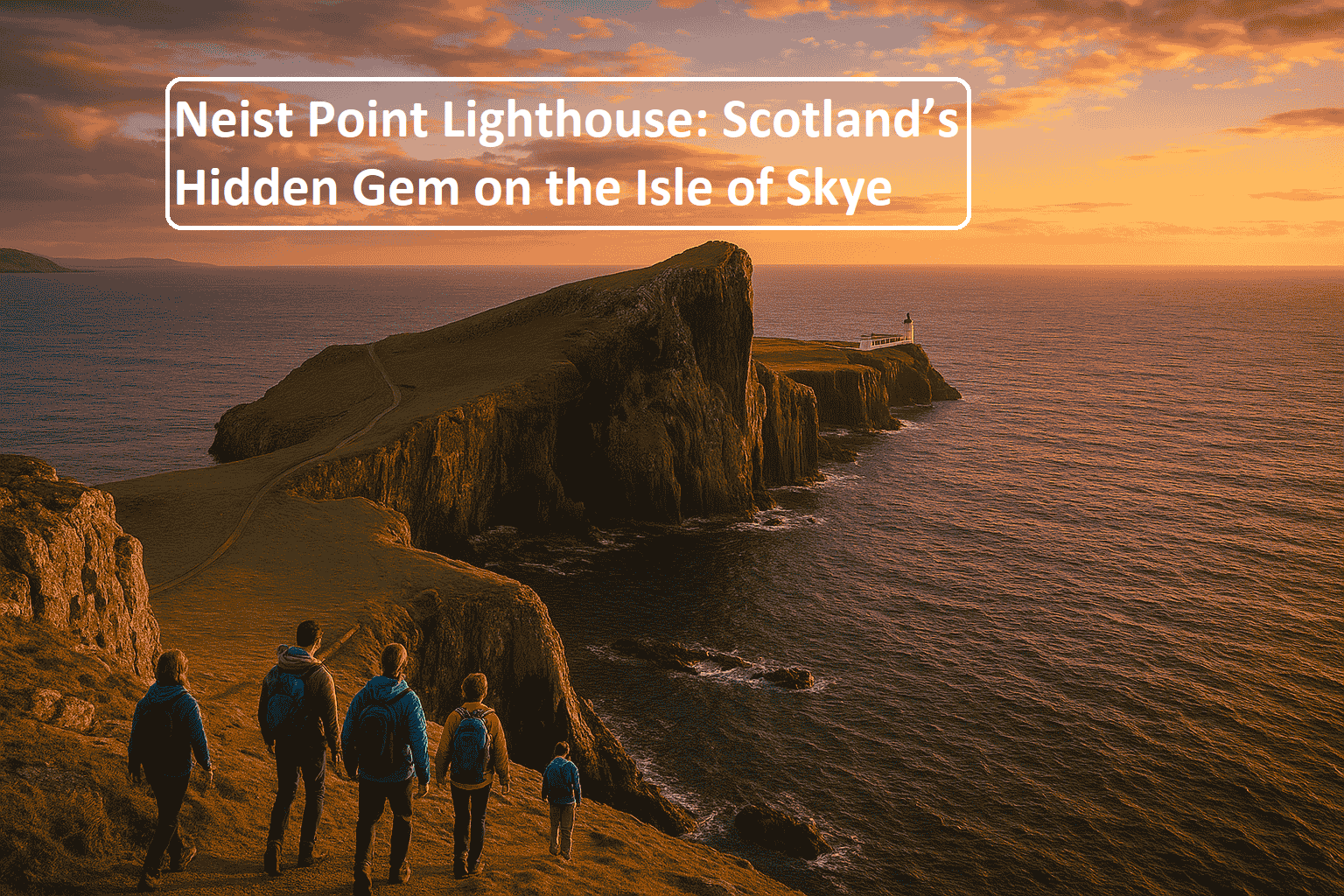Neist Point Lighthouse: Scotland’s Hidden Gem on the Isle of Skye
When most people picture Scotland, they imagine rolling green hills, rugged coastlines, and timeless castles. But tucked away on the far western edge of the Isle of Skye stands Neist Point Lighthouse, one of the most breathtaking spots in the UK. This iconic landmark isn’t just about guiding ships at sea—it’s a place that combines natural beauty, history, and a sense of adventure all in one. Whether you’re planning your first trip to Scotland, curious about Scottish history, or simply love lighthouses, this guide will take you on a deep dive into everything you need to know about Neist Point Lighthouse.
The Dramatic Cliffs of Neist Point
One of the most awe-inspiring features of Neist Point is its towering cliffs. Rising abruptly from the restless Atlantic, these rugged formations showcase the raw power of nature. They’ve been shaped by centuries of wind, waves, and weather, leaving behind dramatic edges that look as if they’ve been carved for a movie set. Photographers often describe the cliffs as “otherworldly,” especially during golden hour when the sunlight casts long shadows across the rocky face.
For visitors, the cliffs aren’t just a photo opportunity—they’re a reminder of Scotland’s untamed beauty. Standing at the edge, with seabirds wheeling overhead and the sound of waves crashing far below, you feel small in the best possible way. It’s the kind of landscape that pulls you out of your daily routine and reminds you what it means to be fully present. Many travelers say that Neist Point’s cliffs alone are worth the trip to the Isle of Skye.

The Story Behind Neist Point Lighthouse
The history of Neist Point Lighthouse is as captivating as the dramatic cliffs it overlooks. Built in 1909 by David Alan Stevenson, a member of the legendary Stevenson family of lighthouse engineers, it was designed to stand as a guardian of Scotland’s rugged western coastline. The Stevensons were responsible for building over 90 Scottish lighthouses, making their name synonymous with maritime safety. Neist Point became one of their most iconic projects, not only because of its remote location but also due to the perilous seas it was built to watch over.
At the time, the Isle of Skye’s western coast was a notorious hazard for mariners. Powerful Atlantic storms, unpredictable fog, and jagged basalt cliffs made sailing treacherous. Ships bound for the Hebrides or navigating the Minch often found themselves at risk of disaster without a guiding light. That’s why Neist Point Lighthouse was erected—a beacon of safety, providing reassurance to sailors braving some of Scotland’s wildest waters. For decades, the lighthouse was manned by dedicated keepers, who lived in near isolation at the edge of the world, ensuring the light never faltered.
For almost a century, the lighthouse keepers and their families endured fierce winds, solitude, and the relentless Atlantic waves. Their commitment kept countless ships safe from tragedy. In 1990, however, Neist Point Lighthouse was fully automated, joining the ranks of modern Scottish lighthouses managed remotely. While its lantern still shines as a navigational aid, the site has since taken on a new role—one that blends heritage with tourism. Today, Neist Point is more than just a beacon for sailors; it’s a must-visit attraction on the Isle of Skye, drawing travelers from across the globe who come to admire its panoramic views, learn about its fascinating past, and experience the raw beauty of Scotland’s western frontier.
From its Stevenson-engineered legacy to its place in modern travel guides, Neist Point Lighthouse continues to symbolize strength, endurance, and the timeless connection between Scotland’s history and the sea.

Why Neist Point Lighthouse Is a Must-Visit
If you ask locals or seasoned travelers about their favorite spot on the Isle of Skye in Scotland, Neist Point Lighthouse almost always makes the list. This isn’t just another tourist attraction—it’s a destination that blends history, nature, and raw Scottish beauty into one unforgettable experience. But what exactly makes Neist Point Lighthouse a must-visit landmark in Scotland? Let’s break it down.
🌊 1. The Unforgettable Views
Standing at Neist Point, you’re treated to sweeping, unobstructed views of the Atlantic Ocean. The cliffs drop dramatically into the sea, while seabirds circle below, creating a true wildlife spectacle. On clear days, visitors can spot whales, dolphins, and basking sharks offshore, making this one of the best wildlife-watching spots on the Isle of Skye. Sunset lovers especially flock here, as the golden light bathes the cliffs and lighthouse in an almost magical glow.
🚶 2. The Scenic Walk to Neist Point
Getting to the lighthouse isn’t just about the destination—the Neist Point walk itself is a highlight. The trail winds along grassy slopes, rocky paths, and dramatic drops, offering one of the best hikes on the Isle of Skye for all skill levels. Each twist of the path reveals new perspectives of the cliffs and sea, ensuring the journey feels like part of the adventure. The hiking trail to Neist Point is short enough for casual walkers but thrilling enough to leave a lasting impression.
📸 3. A Photographer’s Dream
Neist Point Lighthouse is often called “the most photographed spot on the Isle of Skye”—and for good reason. The combination of towering cliffs, crashing waves, and the iconic white lighthouse creates postcard-perfect moments at every angle. Whether you’re a professional photographer chasing the perfect landscape shot or a traveler with just a smartphone, Neist Point offers endless opportunities for stunning photos. Sunrise and sunset are particularly spectacular, when the colors of the sky reflect off the Atlantic and cast dramatic shadows over the cliffs.
🌍 4. The “Edge of the World” Feeling
Many describe Neist Point as standing at “the edge of the world.” When you’re there, surrounded by endless ocean, jagged cliffs, and raw Scottish wilderness, it’s easy to see why. The sense of isolation is profound—yet it’s also peaceful. Neist Point isn’t just a place to take pictures; it’s a place to reflect, breathe, and connect with Scotland’s natural beauty. It’s no wonder this lighthouse has become one of the top-rated attractions on the Isle of Skye.
How to Get to Neist Point Lighthouse
Reaching Neist Point Lighthouse isn’t just about the destination—it’s part of the adventure itself. Located on the Duirinish Peninsula on the western coast of the Isle of Skye, the journey offers breathtaking views, winding roads, and that distinct Highland charm. Whether you’re driving yourself, joining a tour, or planning a photography trip, here’s everything you need to know.
Visiting with a Tour
If you’re not confident about driving on narrow Highland roads, guided tours are a fantastic alternative.
- Many Isle of Skye day tours and multi-day Highland tours include Neist Point in their itineraries.
- Tours often depart from Edinburgh, Inverness, or Portree, and they typically combine Neist Point with other highlights such as the Fairy Pools, Old Man of Storr, and Quiraing.
- The advantage of a tour is the stress-free experience—you don’t have to worry about navigation or parking, and you’ll often get fascinating stories and local insights from the guide.
Parking at Neist Point
Parking is straightforward but limited.
- There is a small car park at the trailhead, right before the path leading to the lighthouse.
- During peak tourist season (summer months), the lot fills up quickly, so it’s best to arrive early in the morning or later in the evening.
- If the car park is full, avoid blocking roads or driveways—local residents rely on these single-track lanes.
👉 Insider Tip: Time your visit around sunset. Watching the lighthouse glow against a backdrop of pink and orange skies is an unforgettable experience.
The Walk to Neist Point
The path to Neist Point Lighthouse is about 1.5 miles (2.4 km) round trip, and while not extremely long, it can be challenging in places.
- The first section includes steep concrete steps down from the car park.
- From there, the path undulates with a few climbs and drops before reaching the lighthouse.
- Expect strong winds—this is Skye, after all!
👉 Wear sturdy shoes, bring a jacket, and allow about an hour or more to fully enjoy the walk and views.
For families, the path is doable but may be tough for very young children or anyone with mobility issues.
What You’ll See Along the Way
The scenery at Neist Point is unforgettable:
- Wildlife: Look out for seabirds like gannets and fulmars. Lucky visitors sometimes spot seals basking on rocks or whales breaching offshore.
- Cliffs: The dramatic vertical cliffs are a reminder of nature’s power. They also make for incredible photo opportunities.
- Endless Sea: On a clear day, you can even see across to the Outer Hebrides.
Many visitors say that Neist Point is as much about the journey as the destination—the changing light, shifting weather, and sweeping vistas make every step unique.
Best Time to Visit Neist Point Lighthouse
The Isle of Skye is famous for unpredictable weather, but that only adds to the charm. Here’s when to go:
- Summer (June–August): Longer daylight hours, warmer weather, and vibrant green landscapes. Expect more tourists.
- Spring (April–May): Fewer crowds, blooming wildflowers, and great wildlife spotting opportunities.
- Autumn (September–October): Stunning golden light, fewer visitors, and crisp air.
- Winter (November–March): Short days and harsh weather, but dramatic skies and true solitude.
👉 Sunset is the golden hour at Neist Point. Photographers from around the world travel here for that magical light.
Where to Stay Near Neist Point
While you can visit Neist Point in a day, staying nearby allows you to soak up more of Skye’s charm. Options include:
- B&Bs and Guesthouses: Local stays in villages like Glendale or Dunvegan offer cozy Highland hospitality.
- Hotels: Dunvegan has several small hotels, perfect for those wanting comfort and proximity.
- Self-Catering Cottages: Ideal for families or groups who want more privacy.
👉 Pro Tip: Book early! Skye is popular, and accommodations fill quickly, especially in summer.
Photography Tips for Neist Point Lighthouse
If photography is your goal, Neist Point is paradise. Here are some tips:
- Golden Hour Magic: Visit at sunrise or sunset for the best natural light.
- Use a Tripod: Especially useful for long-exposure shots of waves.
- Composition Matters: Frame the lighthouse with cliffs or the ocean for added drama.
- Drone Photography: Allowed, but be respectful of wildlife and other visitors.
Even if you’re not a pro, the views are so spectacular that every shot feels frame-worthy.
FAQs About Neist Point Lighthouse
1. Where is Neist Point Lighthouse located?
It’s on the Duirinish Peninsula, Isle of Skye, Scotland.
2. How long is the Neist Point walk?
About 1.5 miles round trip, taking roughly an hour depending on pace.
3. Is the Neist Point walk difficult?
It’s moderate—steep steps at the start, uneven paths, and strong winds.
4. Can you go inside Neist Point Lighthouse?
No, the lighthouse is closed to the public, but you can explore the surrounding area.
5. What wildlife can I see at Neist Point?
Seabirds, seals, dolphins, and occasionally whales.
6. Is there parking at Neist Point?
Yes, a small car park is available, but it gets busy in peak season.
7. Is Neist Point dog-friendly?
Yes, but keep dogs on a lead near cliffs.
8. What’s the best time to visit Neist Point Lighthouse?
Sunset is ideal for photography and atmosphere.
9. Can you see the Outer Hebrides from Neist Point?
Yes, on a clear day the view stretches across the sea to the Hebrides.
10. Why is Neist Point famous?
Its dramatic cliffs, iconic lighthouse, and world-class views make it one of Scotland’s most photographed locations.
Final Thoughts: Why Neist Point Should Be on Your Bucket List
Neist Point Lighthouse isn’t just another stop on the Isle of Skye—it’s a place that captures the spirit of Scotland. From its rich history to its breathtaking natural setting, it offers visitors an unforgettable experience.
If you’re planning a trip to Scotland, make sure Neist Point is on your itinerary. Take your time, walk the trail, breathe in the Atlantic air, and let the magic of this hidden gem sink in.




